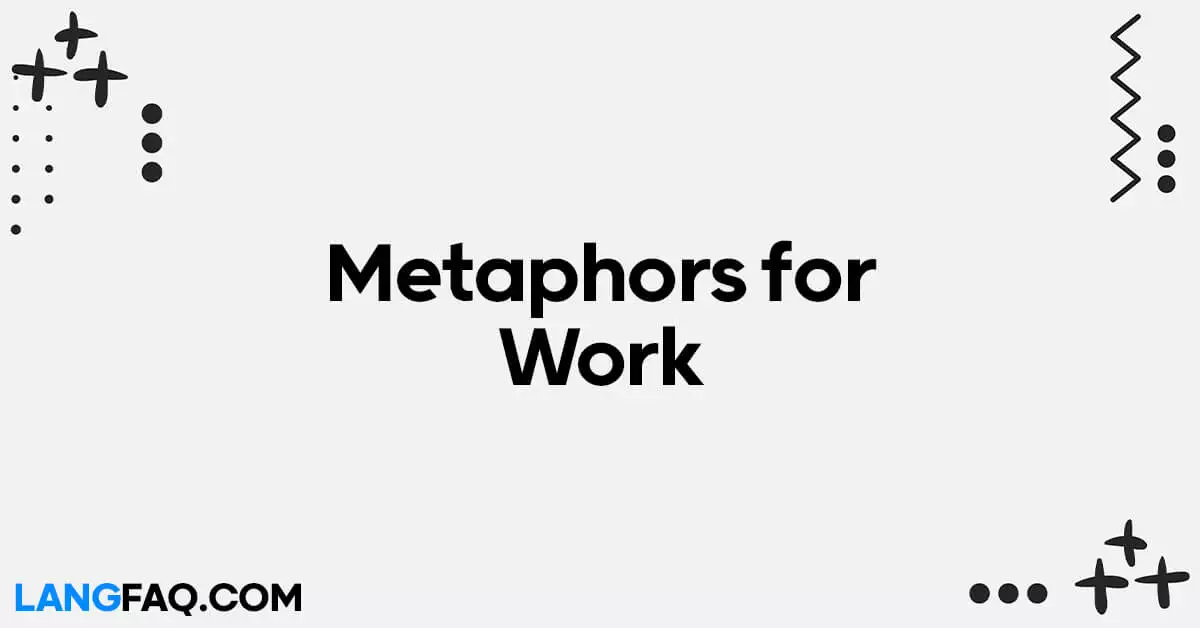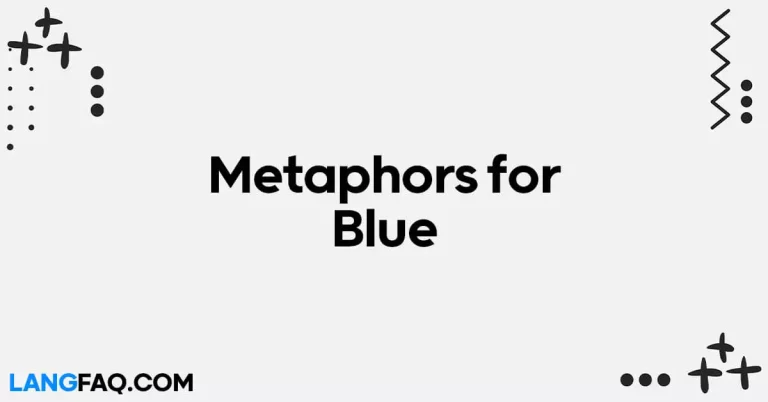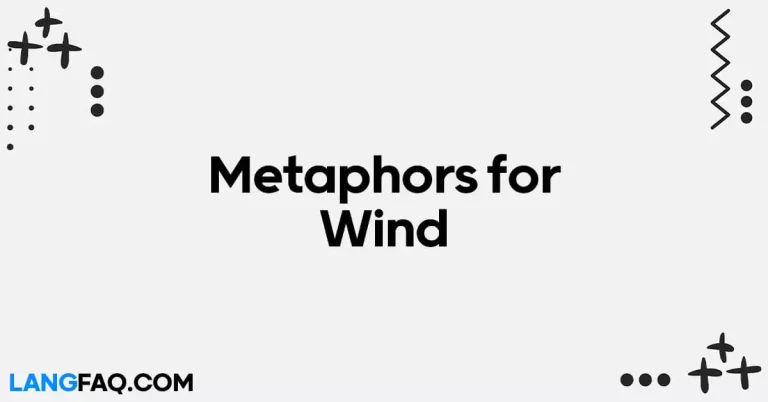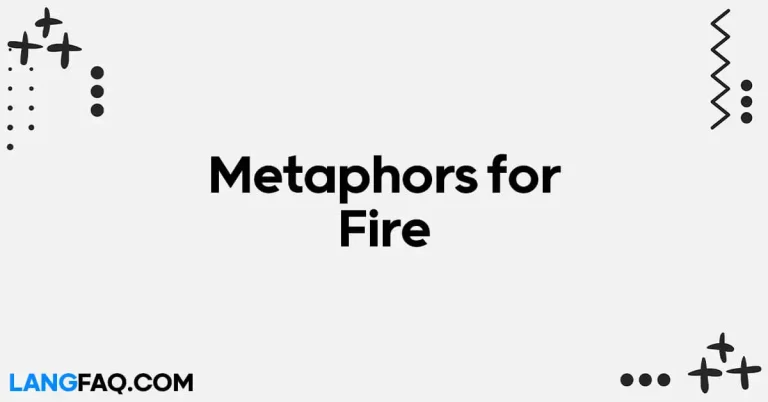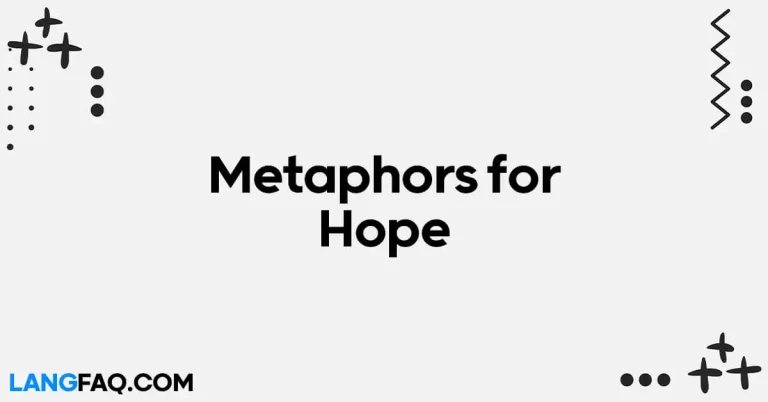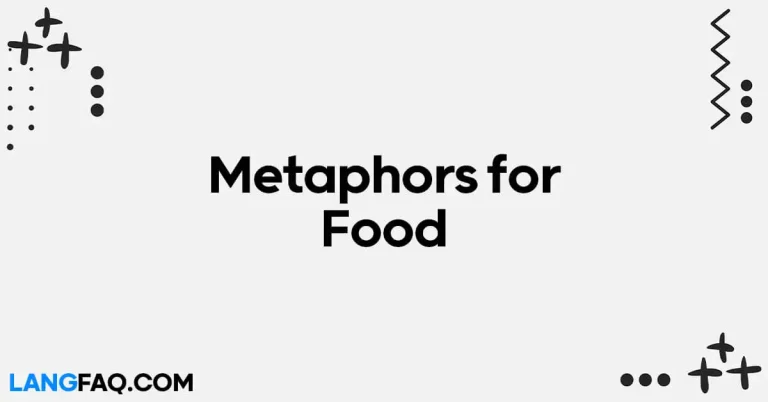Work, in all its forms and facets, is a fundamental part of our lives. Whether you’re in a corporate setting, pursuing a creative passion, or engaged in manual labor, work defines a significant portion of your existence. To shed light on this multifaceted concept, we’ve compiled 26 metaphors for work that will not only intrigue but also provide insights into the world of employment.
26 Metaphors for Work
- The Daily Grind: Signifying the routine and repetitive nature of work.
- A Juggling Act: Reflecting the need to balance multiple tasks and responsibilities.
- Climbing the Corporate Ladder: Describing the pursuit of career advancement.
- The 9 to 5 Grind: Symbolizing the typical workday hours.
- Burning the Midnight Oil: Indicating putting in extra effort and long hours.
- Labor of Love: Representing work done with passion and dedication.
- In the Trenches: Referring to dealing with challenges head-on.
- A Well-Oiled Machine: Depicting an efficient and synchronized workplace.
- Sailing Through Work: Suggesting smooth and effortless progress.
- Planting Seeds for the Future: Signifying the investment in long-term goals.
- The Rat Race: Describing the competitive nature of work.
- Cogs in the Machine: Reflecting one’s role as a small part of a larger system.
- Putting Bread on the Table: Indicating the need to earn a living.
- A Blank Canvas: Signifying the creative freedom in certain professions.
- Hitting the Ground Running: Emphasizing a fast and energetic start.
- The Daily Hustle: Referring to putting in extra effort and determination.
- Building Bridges: Signifying the importance of forming connections.
- Walking a Tightrope: Reflecting the need for balance and precision.
- Turning Wheels: Depicting the constant motion of work.
- Fighting Fires: Referring to addressing urgent issues and crises.
- A Piece of Cake: Indicating a task that is effortless and enjoyable.
- On Cloud Nine: Representing the feeling of euphoria when achieving success.
- A Marathon, Not a Sprint: Emphasizing the long-term nature of work.
- The Daily Puzzle: Describing work as a series of problem-solving tasks.
- Minds at Work: Signifying the intellectual aspect of certain professions.
- A Symphony of Effort: Reflecting the importance of teamwork and collaboration in achieving a common goal.
| Metaphor | Meaning | Example |
|---|---|---|
| The Daily Grind | Routine and repetition in work | “Every day, it’s the same tasks – the daily grind.” |
| A Juggling Act | Balancing multiple tasks and responsibilities | “Managing my job, family, and hobbies is a real juggling act.” |
| Climbing the Corporate Ladder | Advancing in one’s career | “She’s been working hard, climbing the corporate ladder.” |
| The 9 to 5 Grind | Typical workday hours | “I’m stuck in the 9 to 5 grind.” |
| Burning the Midnight Oil | Putting in extra effort and long hours | “To meet the deadline, I’ll be burning the midnight oil.” |
| Labor of Love | Work done with passion and dedication | “For her, writing is a labor of love.” |
| In the Trenches | Dealing with challenges head-on | “We’re in the trenches, facing tough competition.” |
| A Well-Oiled Machine | Efficient and synchronized workplace | “The team operates like a well-oiled machine.” |
| Sailing Through Work | Smooth and effortless progress | “With the new system, we’re sailing through work.” |
| Planting Seeds for the Future | Investing in long-term goals | “Each project is like planting seeds for the future.” |
| The Rat Race | Competitive nature of work | “He’s caught up in the corporate rat race.” |
| Cogs in the Machine | Being a small part of a larger system | “We’re all just cogs in the machine.” |
| Putting Bread on the Table | Need to earn a living | “I work hard to put bread on the table for my family.” |
| A Blank Canvas | Creative freedom in certain professions | “As a designer, I see each project as a blank canvas.” |
| Hitting the Ground Running | Fast and energetic start | “I joined the team and hit the ground running.” |
| The Daily Hustle | Putting in extra effort and determination | “To succeed, you need the daily hustle.” |
| Building Bridges | Importance of forming connections | “Networking is about building bridges.” |
| Walking a Tightrope | Need for balance and precision | “Managing the budget feels like walking a tightrope.” |
| Turning Wheels | Constant motion of work | “In this industry, we’re always turning wheels.” |
| Fighting Fires | Addressing urgent issues and crises | “Today, I’m busy fighting fires at the office.” |
| A Piece of Cake | Effortless and enjoyable task | “Completing this project was a piece of cake.” |
| On Cloud Nine | Feeling of euphoria when achieving success | “After winning the award, she was on cloud nine.” |
| A Marathon, Not a Sprint | Long-term nature of work | “Success in this field is a marathon, not a sprint.” |
| The Daily Puzzle | Work as a series of problem-solving tasks | “Each project presents a new daily puzzle to solve.” |
| Minds at Work | Intellectual aspect of certain professions | “In research, it’s all about putting our minds at work.” |
| A Symphony of Effort | Importance of teamwork and collaboration | “Our team’s success is a symphony of effort.” |
These metaphors provide vivid imagery and deeper insights into the world of work.
The Daily Grind: Embracing Routine and Repetition
Definition: The phrase “The Daily Grind” refers to the regular and repetitive nature of work. It highlights the tasks that make up your everyday professional life.
Usage Scenario (Formal): In a formal email to a colleague, you might write, “I understand that the daily grind of meetings and reports can be challenging, but it’s essential for our team’s success.”
Usage Scenario (Informal): In a casual conversation with a friend, you could say, “You know, the daily grind at the office can get monotonous, but it pays the bills.”
Variations:
- The Daily Routine: A slightly less informal version that can be used in various contexts.
- The Monotonous Task List: Emphasizes the repetitive nature of the work.
A Juggling Act: Balancing Responsibilities Like a Pro
Definition: “A Juggling Act” signifies the skillful balance of multiple tasks and responsibilities in your professional life. It conveys the idea of managing various aspects effectively.
Usage Scenario (Formal): In a business meeting, you might state, “Our project requires a real juggling act between time, budget, and quality.”
Usage Scenario (Informal): Talking to a mentor, you could say, “Managing work, family, and my side hustle is like a constant juggling act.”
Variations:
- Balancing Act: A more straightforward alternative that carries a similar meaning.
- The Multitasking Challenge: Emphasizes handling several tasks simultaneously.
Climbing the Corporate Ladder: Pursuing Career Advancement
Definition: “Climbing the Corporate Ladder” symbolizes the journey of advancing in one’s career, often with the goal of reaching higher positions within a company or industry.
Usage Scenario (Formal): In a job interview, you might explain, “I’m motivated by the opportunity to climb the corporate ladder and contribute to the company’s growth.”
Usage Scenario (Informal): Sharing career aspirations with a friend, you could say, “I’ve always been ambitious, and climbing the corporate ladder is my goal.”
Variations:
- Advancing in the Workplace: A more general expression suitable for various professional settings.
- Career Progression: A formal term often used in resumes and cover letters.
The 9 to 5 Grind: Navigating Typical Workday Hours
Definition: “The 9 to 5 Grind” represents the standard work hours for many professionals. It alludes to the routine of daily work within these specific timeframes.
Usage Scenario (Formal): In a project proposal, you might state, “Our team will be available during the 9 to 5 grind to address any client inquiries.”
Usage Scenario (Informal): Chatting with a colleague about your schedule, you could say, “I’ll be in the office during the 9 to 5 grind tomorrow.”
Variations:
- The Standard Workday: A more neutral way to refer to typical work hours.
- Business Hours: A formal term often used in customer service contexts.
Burning the Midnight Oil: Dedication and Extra Effort
Definition: “Burning the Midnight Oil” signifies putting in extra effort and long hours to accomplish a task or meet a deadline. It reflects dedication and commitment.
Usage Scenario (Formal): In a project update email, you might write, “Our team has been burning the midnight oil to finalize the presentation for the client.”
Usage Scenario (Informal): Talking to a fellow student about exam preparation, you could say, “I had to burn the midnight oil to pass that test.”
Variations:
- Working Late: A simpler way to convey the same idea.
- Late-Night Grind: A more casual expression for putting in extra hours.
Labor of Love: Passion and Dedication in Your Work
Definition: “Labor of Love” represents work done with passion, enthusiasm, and dedication. It implies that the task is enjoyable and fulfilling.
Usage Scenario (Formal): In a conference presentation, you might share, “Our team’s project was truly a labor of love, driven by our passion for innovation.”
Usage Scenario (Informal): Discussing your hobbies with a friend, you could say, “Painting has always been my labor of love.”
Variations:
- Passionate Pursuit: A more formal way to convey your enthusiasm.
- Heartfelt Effort: A subtle alternative for emphasizing dedication.
In the Trenches: Facing Challenges Head-On
Definition: “In the Trenches” describes the act of dealing with challenges, often difficult or intense ones, directly and fearlessly. It reflects the willingness to confront and overcome obstacles.
Usage Scenario (Formal): In a project status report, you might state, “Our team is in the trenches, addressing the technical issues head-on.”
Usage Scenario (Informal): Sharing your experiences with a mentor, you could say, “During the crisis, I felt like I was in the trenches, but we managed to resolve it.”
Variations:
- Confronting Challenges: A straightforward and formal alternative.
- Facing Adversity: A more solemn expression for dealing with difficulties.
A Well-Oiled Machine: Efficiency and Synergy
Definition: “A Well-Oiled Machine” characterizes an efficient workplace where all components work smoothly together, emphasizing the importance of teamwork and synergy.
Usage Scenario (Formal): During a corporate presentation, you might explain, “Our department functions like a well-oiled machine, ensuring streamlined operations.”
Usage Scenario (Informal): Chatting with a colleague about a successful project, you could say, “Our teamwork made it feel like we were a well-oiled machine.”
Variations:
- Efficient Collaboration: A formal way to highlight effective teamwork.
- Seamless Operations: Emphasizing smooth and coordinated processes.
Sailing Through Work: Smooth Progress
Definition: “Sailing Through Work” suggests that progress at work is effortless and free of significant obstacles. It conveys the idea of smooth and trouble-free advancement.
Usage Scenario (Formal): In a progress report to management, you might state, “Our project has been sailing through work, meeting all milestones on time.”
Usage Scenario (Informal): Discussing your workday with a friend, you could say, “Today was great; I was sailing through work with no issues.”
Variations:
- Effortless Progress: A more straightforward expression.
- Smooth Advancement: A formal term for seamless progress.
Planting Seeds for the Future: Building a Foundation
Definition: “Planting Seeds for the Future” signifies the act of investing effort or resources today with the expectation of future growth or benefits. It emphasizes the importance of long-term planning.
Usage Scenario (Formal): In a strategic business proposal, you might explain, “Our investment strategy focuses on planting seeds for the future, ensuring sustainable growth.”
Usage Scenario (Informal): Discussing career development with a mentor, you could say, “I believe in planting seeds for the future by acquiring new skills.”
Variations:
- Building for Tomorrow: A more direct way to convey future-oriented efforts.
- Investing in Long-Term Success: A formal expression of the same concept.
The Rat Race: Competitive Work Environment
Definition: “The Rat Race” describes a highly competitive work environment where individuals vie for success, often at a frenetic pace. It underscores the intense competition in certain industries or professions.
Usage Scenario (Formal): In a market analysis report, you might note, “The industry is characterized by a relentless rat race for market share.”
Usage Scenario (Informal): Chatting with a colleague about career aspirations, you could say, “I want to succeed, but I don’t want to get caught up in the rat race.”
Variations:
- Competitive Arena: A more formal term for describing a competitive environment.
- Intense Competition: A straightforward alternative for emphasizing competition.
Cogs in the Machine: Individual Contributions to a Whole
Definition: “Cogs in the Machine” conveys the idea that individuals are like small parts or components in a larger system or organization, each contributing to the overall functioning.
Usage Scenario (Formal): In an organizational structure discussion, you might explain, “Every employee plays a crucial role as one of the cogs in the machine.”
Usage Scenario (Informal): Talking to a team member about collaboration, you could say, “We all have unique roles, but we’re like cogs in the machine working together.”
Variations:
- Integral Components: A more formal way to describe individual contributions.
- Team Players: A casual term for emphasizing collaboration within a group.
Putting Bread on the Table: Providing Financial Support
Definition: “Putting Bread on the Table” signifies the act of earning a living and providing financial support for oneself or one’s family.
Usage Scenario (Formal): In a financial planning seminar, you might state, “The goal is to achieve financial stability and ensure everyone can put bread on the table.”
Usage Scenario (Informal): Discussing career choices with a friend, you could say, “I chose this profession because it allows me to put bread on the table and pursue my passions.”
Variations:
- Earning a Living: A straightforward and formal expression.
- Financial Support: A more neutral term for providing for oneself or others.
A Blank Canvas: Creativity and Freedom in Work
Definition: “A Blank Canvas” signifies the creative freedom and opportunity for innovation in certain professions or projects. It suggests that work can be a space for artistic expression and fresh ideas.
Usage Scenario (Formal): During a design conference, you might say, “Our approach is to view each project as a blank canvas, allowing for maximum creativity.”
Usage Scenario (Informal): Chatting with a creative colleague about a new project, you could say, “I love starting with a blank canvas; it’s where my ideas flow freely.”
Variations:
- Creative Exploration: A more formal way to describe the creative process.
- Freedom for Innovation: A formal term emphasizing creative freedom.
Hitting the Ground Running: Fast and Energetic Start
Definition: “Hitting the Ground Running” conveys the idea of starting a project or a new job with enthusiasm and energy, without delay or hesitation.
Usage Scenario (Formal): In a project kickoff meeting, you might state, “Our goal is to hit the ground running and achieve early milestones.”
Usage Scenario (Informal): Talking to a friend about a new job, you could say, “I’m excited to start next week and hit the ground running.”
Variations:
- Starting Strong: A more formal way to express the idea of a dynamic start.
- Energetic Kickoff: A formal expression for a high-energy beginning.
The Daily Hustle: Putting in Extra Effort
Definition: “The Daily Hustle” represents the practice of putting in extra effort, determination, and hard work to achieve success or meet goals.
Usage Scenario (Formal): In a motivational speech to employees, you might say, “Success requires embracing the daily hustle and going the extra mile.”
Usage Scenario (Informal): Discussing career ambitions with a mentor, you could say, “I’m ready to take on the daily hustle to reach my goals.”
Variations:
- Dedicated Effort: A more formal way to describe consistent hard work.
- Persistent Striving: A formal expression of continuous effort.
Building Bridges: Forming Connections and Relationships
Definition: “Building Bridges” emphasizes the importance of forming connections and relationships at work, often to foster collaboration and achieve common goals.
Usage Scenario (Formal): In a team-building workshop, you might explain, “Effective teamwork relies on building bridges and maintaining strong relationships.”
Usage Scenario (Informal): Chatting with a colleague about networking, you could say, “I believe in building bridges with clients; it leads to better partnerships.”
Variations:
- Cultivating Relationships: A more formal way to describe relationship-building.
- Strengthening Connections: A formal term for emphasizing relationship maintenance.
Walking a Tightrope: Balancing Responsibilities and Priorities
Definition: “Walking a Tightrope” conveys the idea of balancing multiple responsibilities and priorities at work, often in a precarious or challenging situation.
Usage Scenario (Formal): In a time management seminar, you might state, “Efficient leaders excel at walking a tightrope between tasks and priorities.”
Usage Scenario (Informal): Discussing workload with a colleague, you could say, “This week, I’m walking a tightrope between project deadlines and meetings.”
Variations:
- Balancing Act: A more formal and general alternative for describing balance.
- Managing Priorities: A formal term for prioritization skills.
Turning Wheels: Constant Motion in Work
Definition: “Turning Wheels” signifies the constant motion and progress of work, often in the context of business operations or project management.
Usage Scenario (Formal): In a quarterly report, you might note, “Our organization is constantly turning wheels to adapt to market changes.”
Usage Scenario (Informal): Talking to a team member about project updates, you could say, “We’re always turning wheels to meet our targets.”
Variations:
- Continuous Progress: A formal way to express ongoing movement.
- Uninterrupted Workflow: A formal term for describing consistent work processes.
Fighting Fires: Tackling Urgent Issues and Crises
Definition: “Fighting Fires” describes the act of addressing urgent issues, crises, or unforeseen challenges at work with determination and problem-solving skills.
Usage Scenario (Formal): In a crisis management workshop, you might explain, “Effective crisis response involves fighting fires while maintaining composure.”
Usage Scenario (Informal): Discussing a project setback with a colleague, you could say, “We spent the week fighting fires, but we resolved the issue.”
Variations:
- Crisis Management: A more formal way to describe handling crises.
- Urgent Issue Resolution: A formal term for addressing immediate problems.
A Piece of Cake: When Work Feels Effortless
Definition: “A Piece of Cake” conveys the idea that a task or project is incredibly easy and can be accomplished without much effort.
Usage Scenario (Formal): During a project review, you might remark, “The final phase of the project was a piece of cake due to meticulous planning.”
Usage Scenario (Informal): Chatting with a coworker about a routine task, you could say, “Completing those reports is usually a piece of cake for me.”
Variations:
- Effortless Task: A more straightforward and formal expression.
- Simple Endeavor: A formal way to convey the ease of a task.
On Cloud Nine: Celebrating Success
Definition: “On Cloud Nine” signifies a state of extreme happiness, satisfaction, or euphoria, often experienced after achieving a significant success or milestone.
Usage Scenario (Formal): In a congratulatory email to a team, you might write, “We’re all on cloud nine after securing that major client.”
Usage Scenario (Informal): Celebrating a personal accomplishment with friends, you could say, “I’ve been on cloud nine since I got that promotion!”
Variations:
- Over the Moon: A similar informal expression of extreme happiness.
- Ecstatic State: A more formal way to describe intense joy.
A Marathon, Not a Sprint: Embracing Long-Term Commitment
Definition: “A Marathon, Not a Sprint” emphasizes the idea that achieving success in your work often requires long-term commitment, endurance, and persistence.
Usage Scenario (Formal): In a strategic planning meeting, you might advise, “Remember, this project is a marathon, not a sprint; pace yourselves.”
Usage Scenario (Informal): Discussing career goals with a mentor, you could say, “I’ve learned that building a successful career is a marathon, not a sprint.”
Variations:
- Long-Term Pursuit: A more formal way to convey the idea of a sustained effort.
- Endurance Challenge: A formal term emphasizing persistence.
The Daily Puzzle: Work as Problem-Solving
Definition: “The Daily Puzzle” represents work as a series of challenges and problems to be solved. It underscores the problem-solving aspect of certain professions.
Usage Scenario (Formal): In a technical training seminar, you might state, “Engineers view complex problems as the daily puzzle they enjoy solving.”
Usage Scenario (Informal): Discussing a challenging project with a colleague, you could say, “This project is like the daily puzzle I can’t wait to crack.”
Variations:
- Continuous Problem-Solving: A more formal and direct way to describe the process.
- Ongoing Challenges: A formal term emphasizing the difficulties faced.
Minds at Work: Intellectual Engagement in Professions
Definition: “Minds at Work” highlights the intellectual engagement and cognitive processes involved in certain professions. It suggests that work requires active mental effort.
Usage Scenario (Formal): In a research presentation, you might explain, “In academia, we keep our minds at work to push the boundaries of knowledge.”
Usage Scenario (Informal): Discussing a demanding task with a friend, you could say, “Today, it’s all about keeping our minds at work to solve this problem.”
Variations:
- Intellectual Effort: A more formal and neutral expression.
- Cognitive Engagement: A formal term for mental involvement.
A Symphony of Effort: The Beauty of Teamwork
Definition: “A Symphony of Effort” underscores the importance of teamwork and collaboration in achieving a common goal. It likens the coordinated efforts of a team to the harmonious music of a symphony.
Usage Scenario (Formal): During a team-building workshop, you might emphasize, “Our success relies on creating a symphony of effort among team members.”
Usage Scenario (Informal): Celebrating a successful project with coworkers, you could say, “This achievement is the result of our symphony of effort.”
Variations:
- Effective Collaboration: A more formal expression of coordinated teamwork.
- Team Harmony: A formal way to describe smooth teamwork.
The 11th Hour: Nearing the Deadline
Definition: “The 11th Hour” signifies the point in time when a deadline is imminent, and there’s little time left to complete a task or project.
Usage Scenario (Formal): In a project status meeting, you might report, “We’re in the 11th hour of this project, and it’s crucial to meet the deadline.”
Usage Scenario (Informal): Discussing a last-minute assignment with a coworker, you could say, “Looks like we’re in the 11th hour again; let’s get to work!”
Variations:
- Last-Minute Rush: A more direct way to describe the urgency of completing a task.
- Deadline Pressure: A formal term emphasizing the time constraint.
Navigating Stormy Waters: Facing Challenges Head-On
Definition: “Navigating Stormy Waters” conveys the idea of dealing with difficult or turbulent situations, often requiring resilience and determination.
Usage Scenario (Formal): In a crisis management seminar, you might explain, “Effective leaders excel in navigating stormy waters and guiding their teams to safety.”
Usage Scenario (Informal): Discussing a challenging project with a colleague, you could say, “This quarter has been all about navigating stormy waters, but we’re making progress.”
Variations:
- Overcoming Challenges: A more formal and direct alternative.
- Tackling Turbulence: A formal expression emphasizing facing difficulties.
Balancing Act: Managing Multiple Responsibilities
Definition: “Balancing Act” signifies the skillful management of multiple responsibilities and priorities, often requiring careful juggling.
Usage Scenario (Formal): In a leadership training session, you might state, “A successful leader must master the art of the balancing act between work and life.”
Usage Scenario (Informal): Discussing workload with a friend, you could say, “Managing these projects is like a constant balancing act.”
Variations:
- Prioritization Skill: A more formal way to describe the ability to manage tasks effectively.
- Maintaining Equilibrium: A formal term for keeping a balance.
Turning the Page: Embracing Change
Definition: “Turning the Page” conveys the idea of moving forward, often involving a fresh start or embracing change in one’s professional life.
Usage Scenario (Formal): In a company restructuring announcement, you might say, “We’re turning the page and embracing a new era of innovation.”
Usage Scenario (Informal): Discussing career transitions with a mentor, you could say, “It’s time for me to turn the page and explore new opportunities.”
Variations:
- Embracing Change: A more direct and formal alternative.
- Starting Anew: A formal term for beginning afresh.
A Well-Stocked Toolkit: Having a Range of Skills
Definition: “A Well-Stocked Toolkit” suggests having a diverse range of skills and resources at your disposal to tackle various challenges effectively.
Usage Scenario (Formal): In a job interview, you might explain, “I come equipped with a well-stocked toolkit of skills, making me a valuable asset to any team.”
Usage Scenario (Informal): Discussing your strengths with a colleague, you could say, “My experience has given me a well-stocked toolkit for handling complex projects.”
Variations:
- Diverse Skill Set: A more formal and straightforward way to describe a range of skills.
- Comprehensive Resources: A formal term emphasizing a wide range of abilities.
Walking the Talk: Demonstrating Actions Alongside Words
Definition: “Walking the Talk” signifies the act of demonstrating your commitment through your actions rather than just words. It emphasizes the importance of integrity and follow-through.
Usage Scenario (Formal): In a corporate ethics seminar, you might state, “Leaders must lead by example, walking the talk of ethical behavior.”
Usage Scenario (Informal): Discussing leadership qualities with a coworker, you could say, “Our manager is excellent at walking the talk, which inspires the team.”
Variations:
- Integrity in Action: A more formal and direct way to describe demonstrating ethical behavior.
- Living by Principles: A formal term for embodying values through actions.
Riding the Wave: Embracing Momentum
Definition: “Riding the Wave” signifies the act of embracing and capitalizing on momentum or favorable circumstances in your professional life.
Usage Scenario (Formal): In a business strategy meeting, you might state, “Our company is currently riding the wave of market demand, and we need to make the most of it.”
Usage Scenario (Informal): Discussing a successful project with a colleague, you could say, “We’ve been riding the wave of positive feedback from clients lately.”
Variations:
- Capitalizing on Momentum: A more formal and straightforward expression.
- Seizing Opportunities: A formal term emphasizing taking advantage of favorable situations.
The Big Picture: Strategic Thinking
Definition: “The Big Picture” conveys the idea of looking beyond immediate details and considering the broader context and long-term goals in your work.
Usage Scenario (Formal): In a corporate vision statement, you might explain, “Our leaders always focus on the big picture, ensuring our strategies align with our long-term vision.”
Usage Scenario (Informal): Discussing a project with a coworker, you could say, “Let’s not get lost in the details; remember the big picture.”
Variations:
- Strategic Perspective: A more formal and direct alternative for emphasizing long-term thinking.
- Considering the Long View: A formal term for thinking about future outcomes.
Sowing the Seeds: Building Foundations
Definition: “Sowing the Seeds” signifies the act of laying the groundwork or taking initial steps towards future success, often requiring patience and careful planning.
Usage Scenario (Formal): In a project kickoff meeting, you might state, “We are sowing the seeds for innovation with this project, which will yield results in the long run.”
Usage Scenario (Informal): Discussing career aspirations with a mentor, you could say, “I’m ready to sow the seeds of my future success with continuous learning.”
Variations:
- Establishing Foundations: A more formal way to describe building the basis for future achievements.
- Initiating Progress: A formal term for starting forward movement.
Connecting the Dots: Finding Patterns and Solutions
Definition: “Connecting the Dots” conveys the idea of recognizing patterns, relationships, or solutions in complex situations at work.
Usage Scenario (Formal): In a data analysis presentation, you might explain, “Our team excels at connecting the dots in market trends to make informed decisions.”
Usage Scenario (Informal): Discussing problem-solving with a coworker, you could say, “Let’s connect the dots and figure out how to improve our processes.”
Variations:
- Identifying Relationships: A more formal and direct way to describe recognizing connections.
- Solving Puzzles: A formal term for finding solutions in complex situations.
A Double-Edged Sword: Pros and Cons
Definition: “A Double-Edged Sword” signifies a situation or factor that has both advantages and disadvantages, often highlighting the complexity of a decision or action.
Usage Scenario (Formal): In a risk assessment report, you might state, “New technology can be a double-edged sword, offering benefits but also posing security risks.”
Usage Scenario (Informal): Discussing a strategic move with a colleague, you could say, “Expanding into new markets is a double-edged sword; we need to weigh the pros and cons.”
Variations:
- Mixed Blessing: A more formal way to describe a situation with both positive and negative aspects.
- Two-Faced Dilemma: A formal term emphasizing the complexity of a decision.
The Final Stretch: Approaching the End
Definition: “The Final Stretch” signifies the last part of a project or endeavor, often associated with a sense of anticipation and urgency.
Usage Scenario (Formal): In a project status update, you might report, “We’re in the final stretch of development, with just a few details to iron out.”
Usage Scenario (Informal): Discussing a looming deadline with a team member, you could say, “We’re in the final stretch, but we’ll make it!”
Variations:
- Approaching Completion: A more formal and direct way to describe the last phase.
- Endgame Phase: A formal term for the final part of a project.
Frequently Asked Questions (FAQs)
Q: What is the significance of metaphors for work?
A: Metaphors for work offer unique perspectives on the world of employment, helping us understand its complexities and nuances.
Q: How can I make my work more enjoyable?
A: Finding passion and purpose in your work can make it more enjoyable. Consider what aspects of your job resonate with you and focus on them.
Q: Is it essential to climb the corporate ladder?
A: Not everyone’s career path involves climbing the corporate ladder. Success can take different forms, and it’s important to define your own goals.
Q: How can I maintain a work-life balance?
A: Prioritize time management and set boundaries to achieve a healthy work-life balance. Remember that your well-being is paramount.
Q: Can I turn my passion into a career?
A: Yes, many people turn their passions into careers. It may require dedication and perseverance, but it’s possible to pursue what you love.
Q: What is the role of creativity in work?
A: Creativity can enhance problem-solving, innovation, and job satisfaction. It’s a valuable asset in many professions.
Conclusion
Work, as depicted by these 26 metaphors, is a multifaceted journey filled with challenges, opportunities, and personal growth. Embrace the metaphors that resonate with your own work experience, and remember that your path to success is unique. Whether you’re in the daily grind or sailing through work’s calm waters, each metaphor contributes to the rich tapestry of your career.

